Foreword / YouTube Video Review
I purchased these speakers myself with funding from my Patrons.
The review on this website is a brief overview and summary of the objective performance of this speaker. It is not intended to be a deep dive. Moreso, this is information for those who prefer “just the facts” and prefer to have the data without the filler. The video below has more discussion.
Information and Photos
Some specs from the manufacturer:
- Bookshelf speaker with Hi-Res Audio perfect for your home theater or music listening setup
- Amplify your movie, music, and gaming experience with a speaker that provides full frequency audio with a three-way, three-driver speaker system
- ¾ in. super tweeter and 1” tweeter accurately reproduce high frequency sounds for an expansive soundstage
- 5.12” woofer delivers deep, stable bass and detailed mid-range sounds
- Optimized crossover componentry creates clear crisp sound
- 100 W maximum input power
MSRP is approximately $168 USD for the pair. Though, I’ve seen them for much less. I paid $88 for the pair on Black Friday 2021.
If you are interested in purchasing this speaker, please consider using the following affiliate link which earns me a small commission at no additional cost to you: Buy from Amazon
CTA-2034 (SPINORAMA) and Accompanying Data
All data collected using Klippel’s Near-Field Scanner. The Near-Field-Scanner 3D (NFS) offers a fully automated acoustic measurement of direct sound radiated from the source under test. The radiated sound is determined in any desired distance and angle in the 3D space outside the scanning surface. Directivity, sound power, SPL response and many more key figures are obtained for any kind of loudspeaker and audio system in near field applications (e.g. studio monitors, mobile devices) as well as far field applications (e.g. professional audio systems). Utilizing a minimum of measurement points, a comprehensive data set is generated containing the loudspeaker’s high resolution, free field sound radiation in the near and far field. For a detailed explanation of how the NFS works and the science behind it, please watch the below discussion with designer Christian Bellmann:
Based on some trial and error, I found the best vertical reference plane to be at the tweeter (NOT the supertweeter). Though, compromises are made either way. Testing was performed without the grille and the port open unless otherwise stated.
Note: I noticed a strong bit of energy in the -100° vertical response at about 13kHz. I tracked this down to a slightly rattling cable and verified by running a lower-measurement-point scan and the anomaly was gone. Though, the lower number of points results in a lower resolution and rather than present that data, I am presenting the data here with this note and an explanation of what it is. I simply have chosen to prioritize other tests over a re-test of this speaker given that the error is understood and incredibly trivial.
Measurements are provided in a format in accordance with the Standard Method of Measurement for In-Home Loudspeakers (ANSI/CTA-2034-A R-2020). For more information, please see this link.
CTA-2034 / SPINORAMA:
The On-axis Frequency Response (0°) is the universal starting point and in many situations it is a fair representation of the first sound to arrive at a listener’s ears.
The Listening Window is a spatial average of the nine amplitude responses in the ±10º vertical and ±30º horizontal angular range. This encompasses those listeners who sit within a typical home theater audience, as well as those who disregard the normal rules when listening alone.
The Early Reflections curve is an estimate of all single-bounce, first-reflections, in a typical listening room.
Sound Power represents all of the sounds arriving at the listening position after any number of reflections from any direction. It is the weighted rms average of all 70 measurements, with individual measurements weighted according to the portion of the spherical surface that they represent.
Sound Power Directivity Index (SPDI): In this standard the SPDI is defined as the difference between the listening window curve and the sound power curve.
Early Reflections Directivity Index (EPDI): is defined as the difference between the listening window curve and the early reflections curve. In small rooms, early reflections figure prominently in what is measured and heard in the room so this curve may provide insights into potential sound quality.
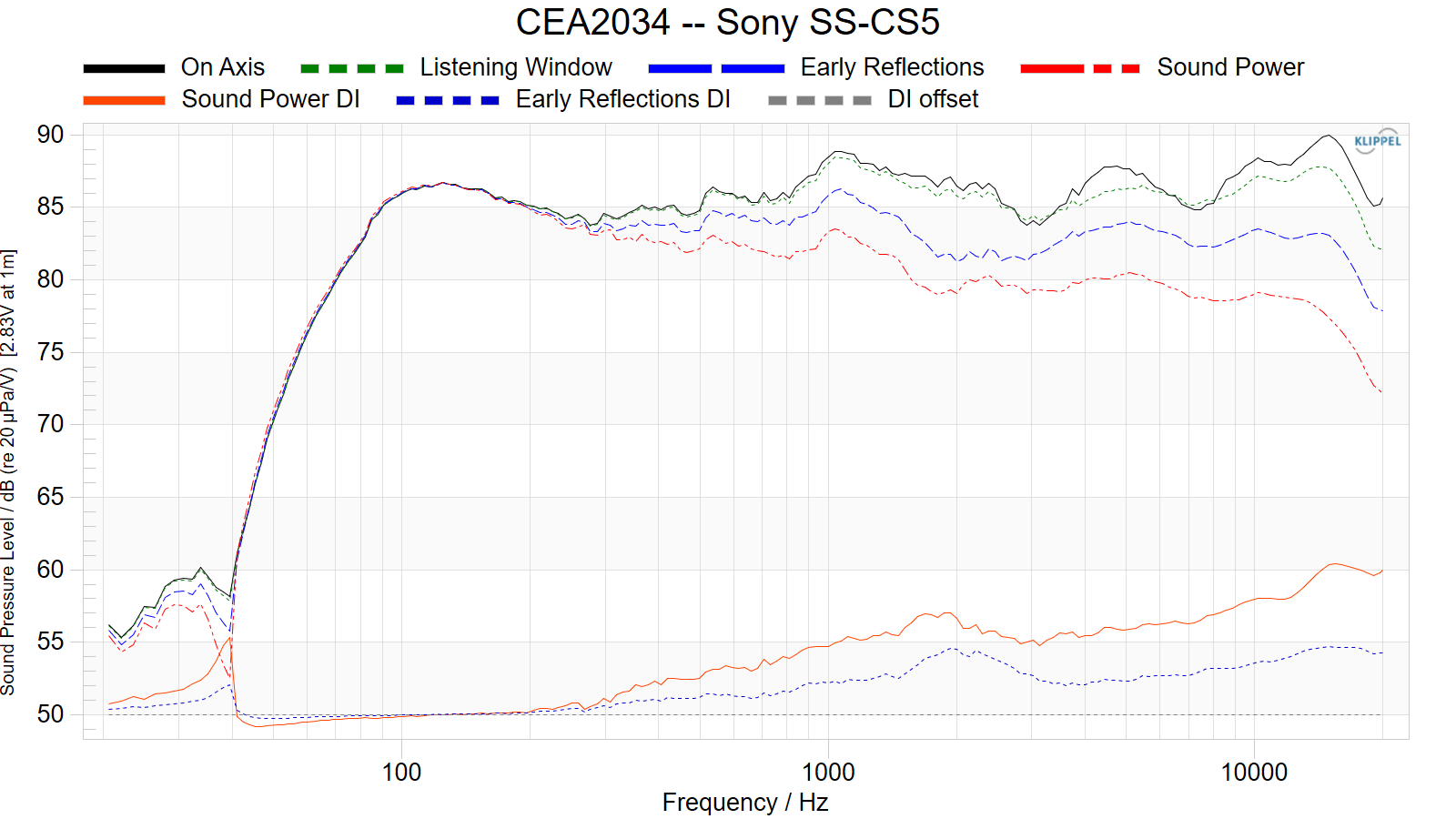
Early Reflections Breakout:
Floor bounce: average of 20º, 30º, 40º down
Ceiling bounce: average of 40º, 50º, 60º up
Front wall bounce: average of 0º, ± 10º, ± 20º, ± 30º horizontal
Side wall bounces: average of ± 40º, ± 50º, ± 60º, ± 70º, ± 80º horizontal
Rear wall bounces: average of 180º, ± 90º horizontal

Estimated In-Room Response:
In theory, with complete 360-degree anechoic data on a loudspeaker and sufficient acoustical and geometrical data on the listening room and its layout it would be possible to estimate with good precision what would be measured by an omnidirectional microphone located in the listening area of that room. By making some simplifying assumptions about the listening space, the data set described above permits a usefully accurate preview of how a given loudspeaker might perform in a typical domestic listening room. Obviously, there are no guarantees, because individual rooms can be acoustically aberrant. Sometimes rooms are excessively reflective (“live”) as happens in certain hot, humid climates, with certain styles of interior décor and in under-furnished rooms. Sometimes rooms are excessively “dead” as in other styles of décor and in some custom home theaters where acoustical treatment has been used excessively. This form of post processing is offered only as an estimate of what might happen in a domestic living space with carpet on the floor and a “normal” amount of seating, drapes and cabinetry.
For these limited circumstances it has been found that a usefully accurate Predicted In-Room (PIR) amplitude response, also known as a “room curve” is obtained by a weighted average consisting of 12 % listening window, 44 % early reflections and 44 % sound power. At very high frequencies errors can creep in because of excessive absorption, microphone directivity, and room geometry. These discrepancies are not considered to be of great importance.

Horizontal Frequency Response (0° to ±90°):

Vertical Frequency Response (0° to ±40°):

Horizontal Contour Plot (not normalized):
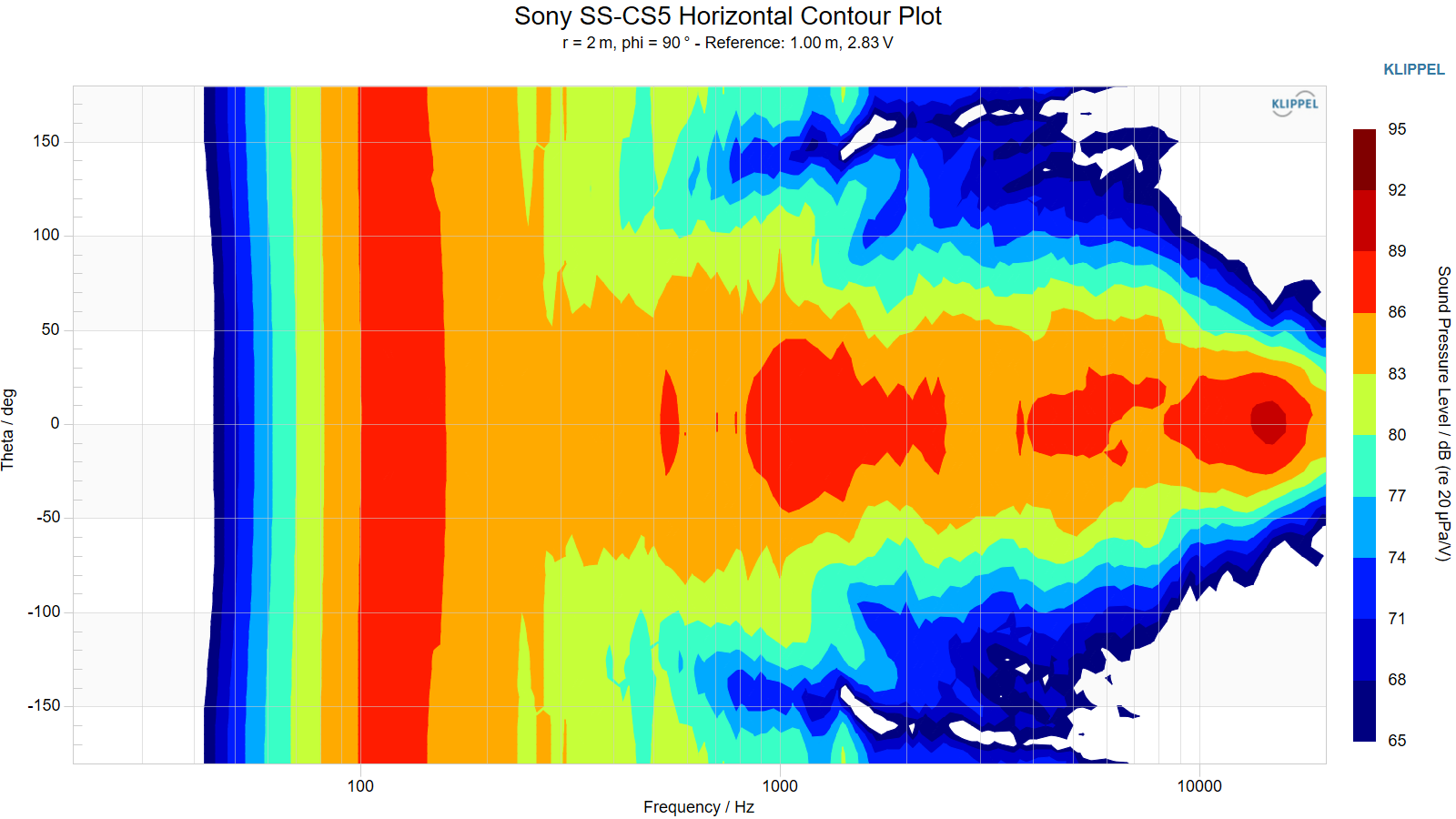
Horizontal Contour Plot (normalized):
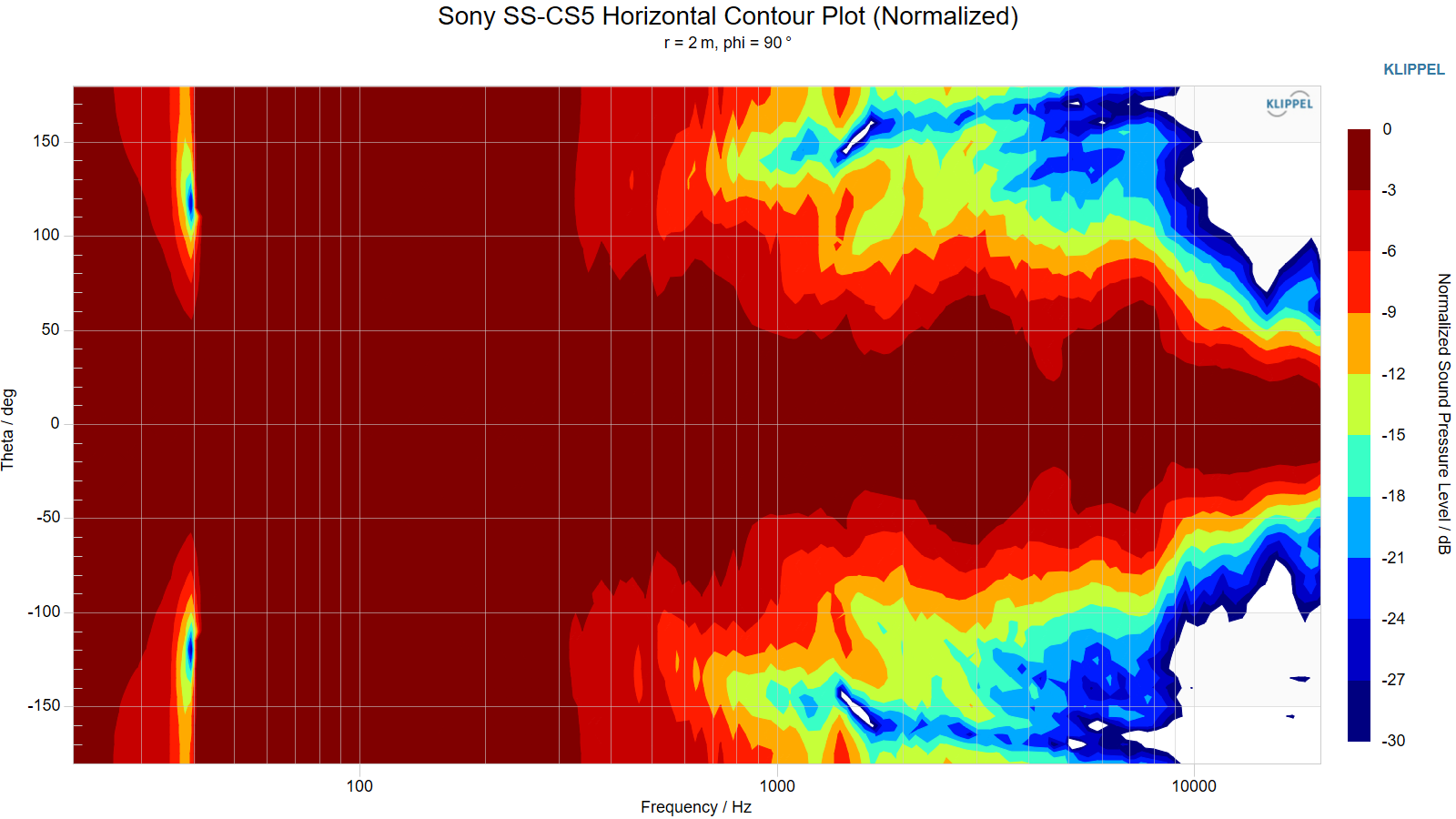
Vertical Contour Plot (not normalized):
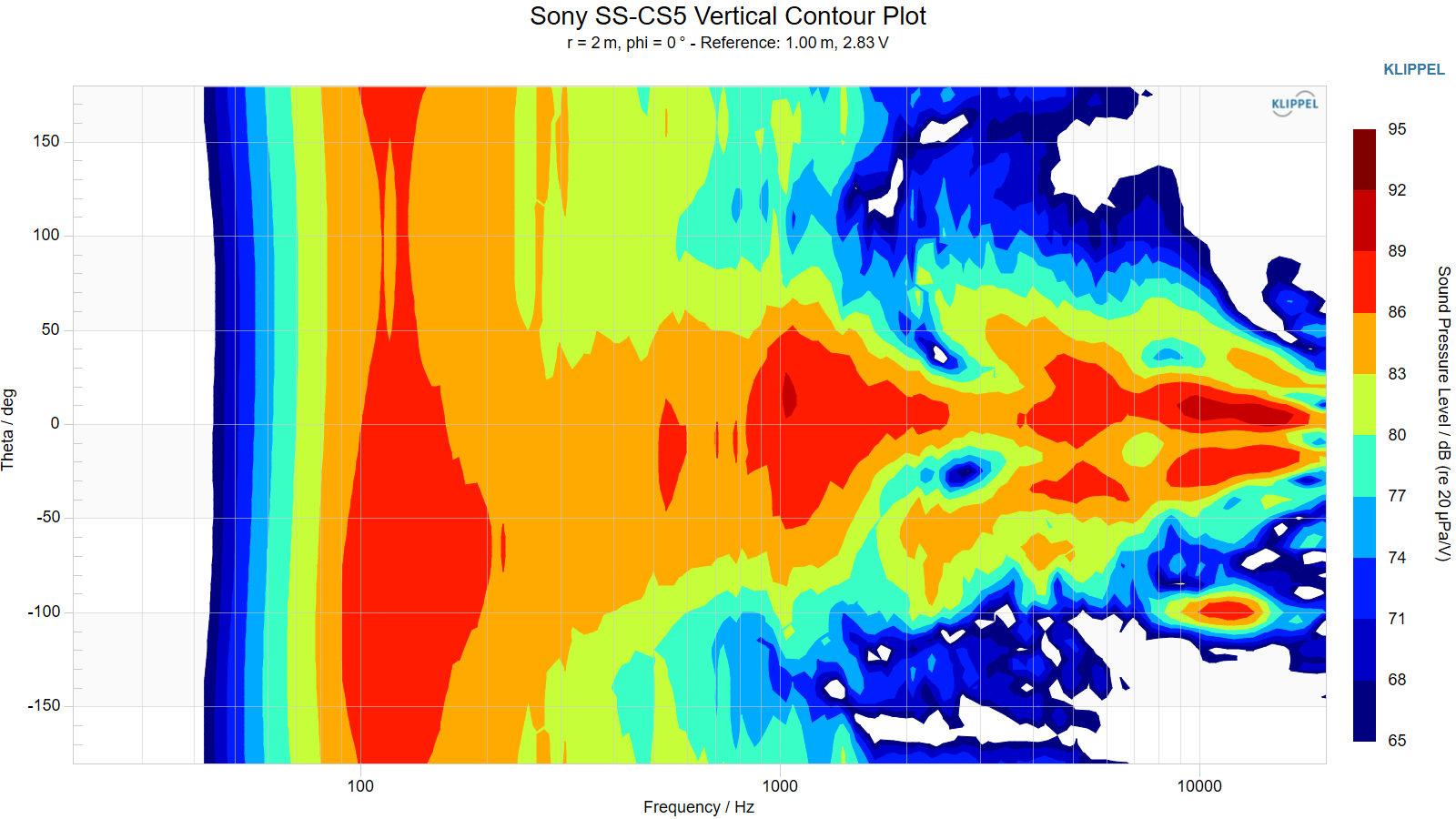
Vertical Contour Plot (normalized):
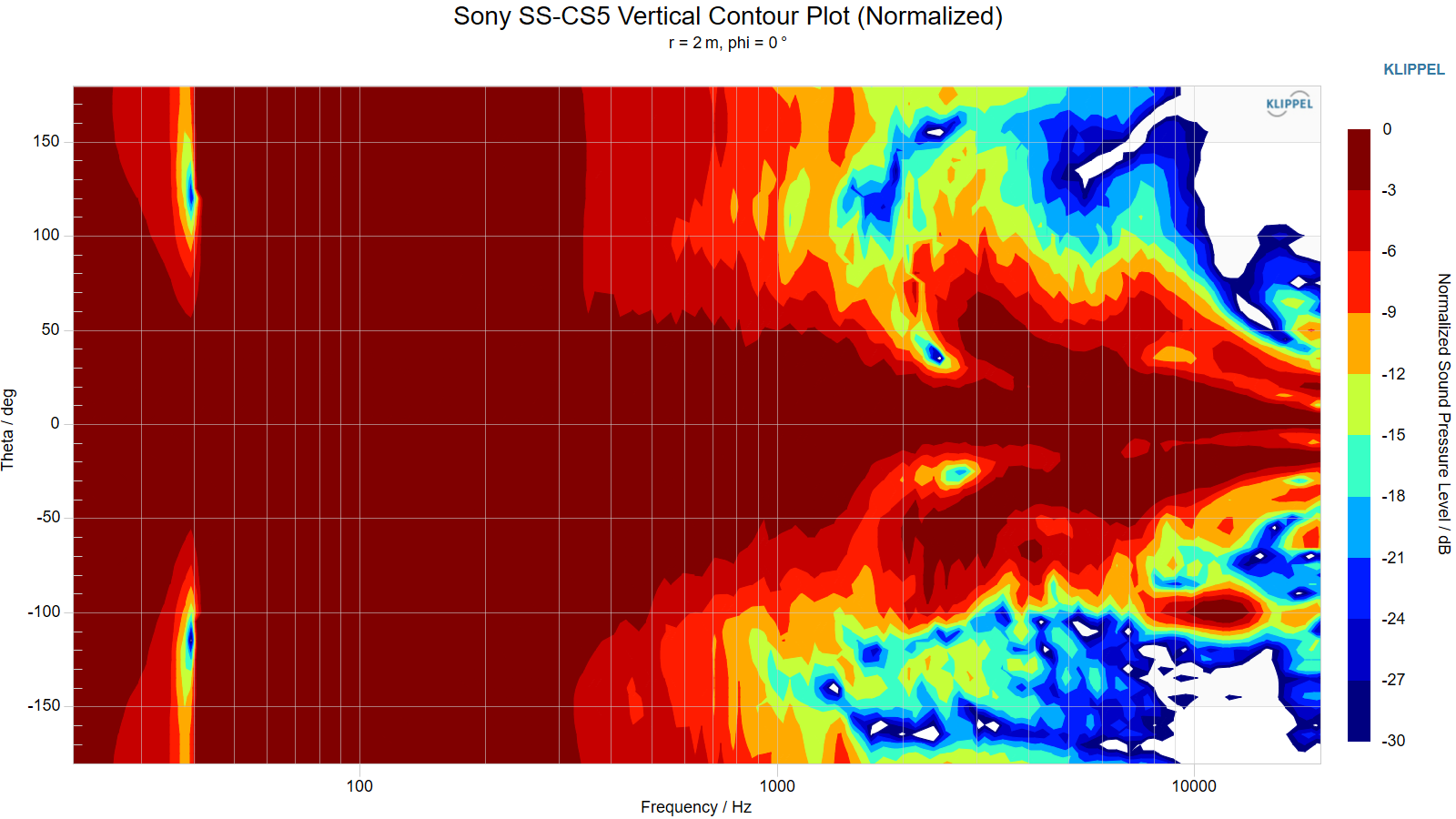
“Globe” Plots
Horizontal Polar (Globe) Plot:
This represents the sound field at 2 meters - above 200Hz - per the legend in the upper left.

Vertical Polar (Globe) Plot:
This represents the sound field at 2 meters - above 200Hz - per the legend in the upper left.

Additional Measurements
On-Axis Response Linearity
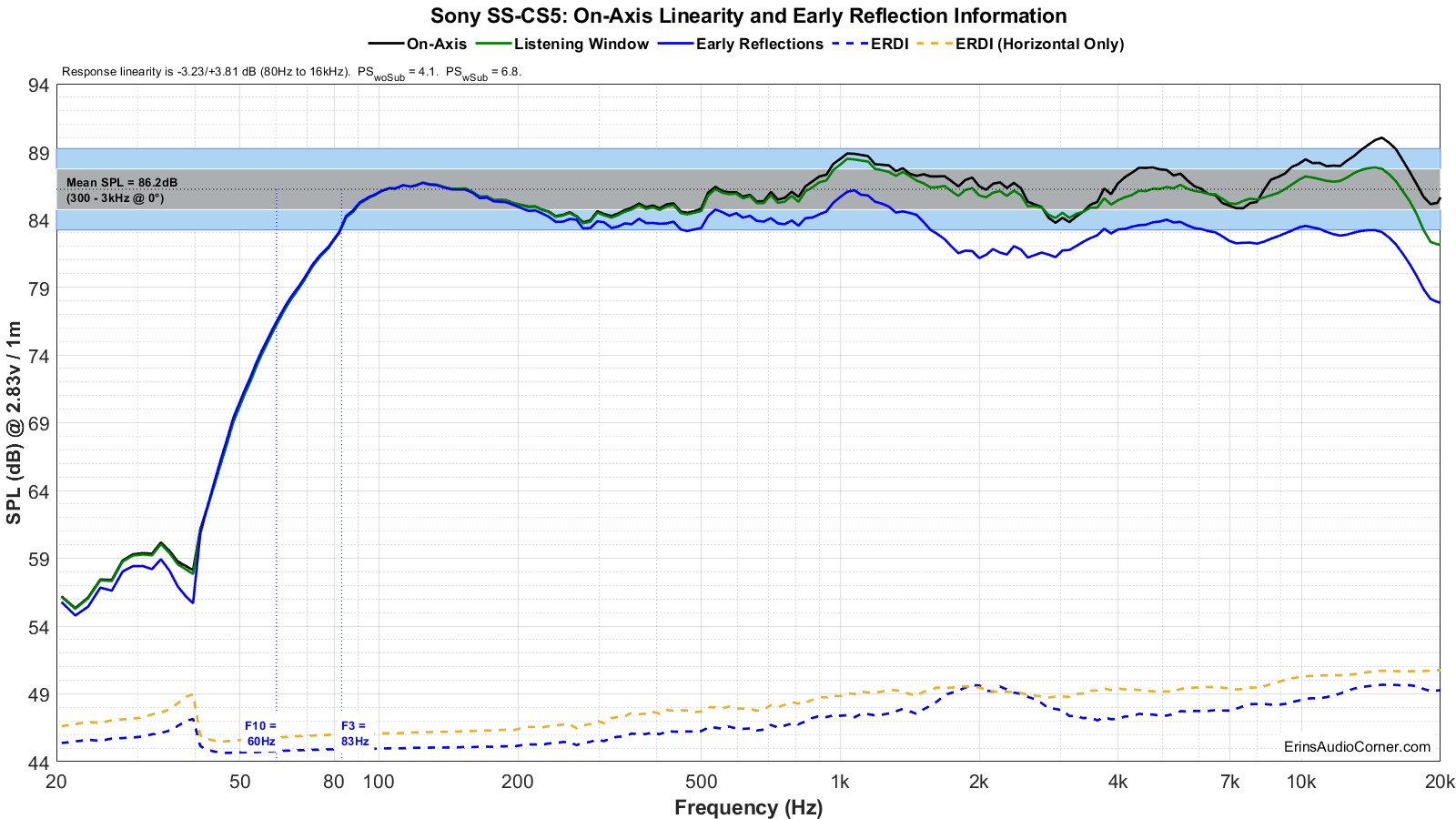
Impedance Magnitude and Phase
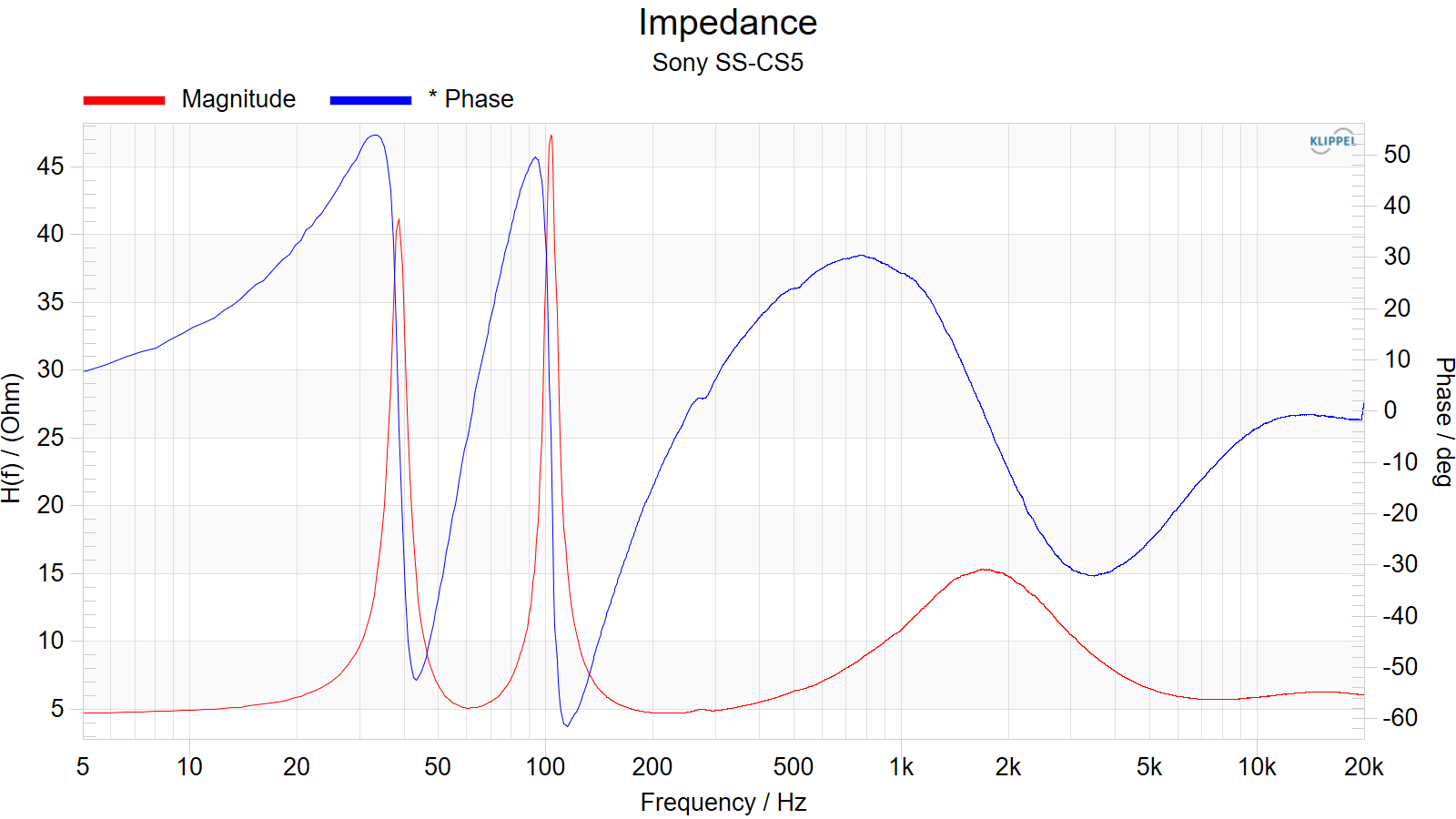
Near-Field Response
Nearfield response of individual drive units:
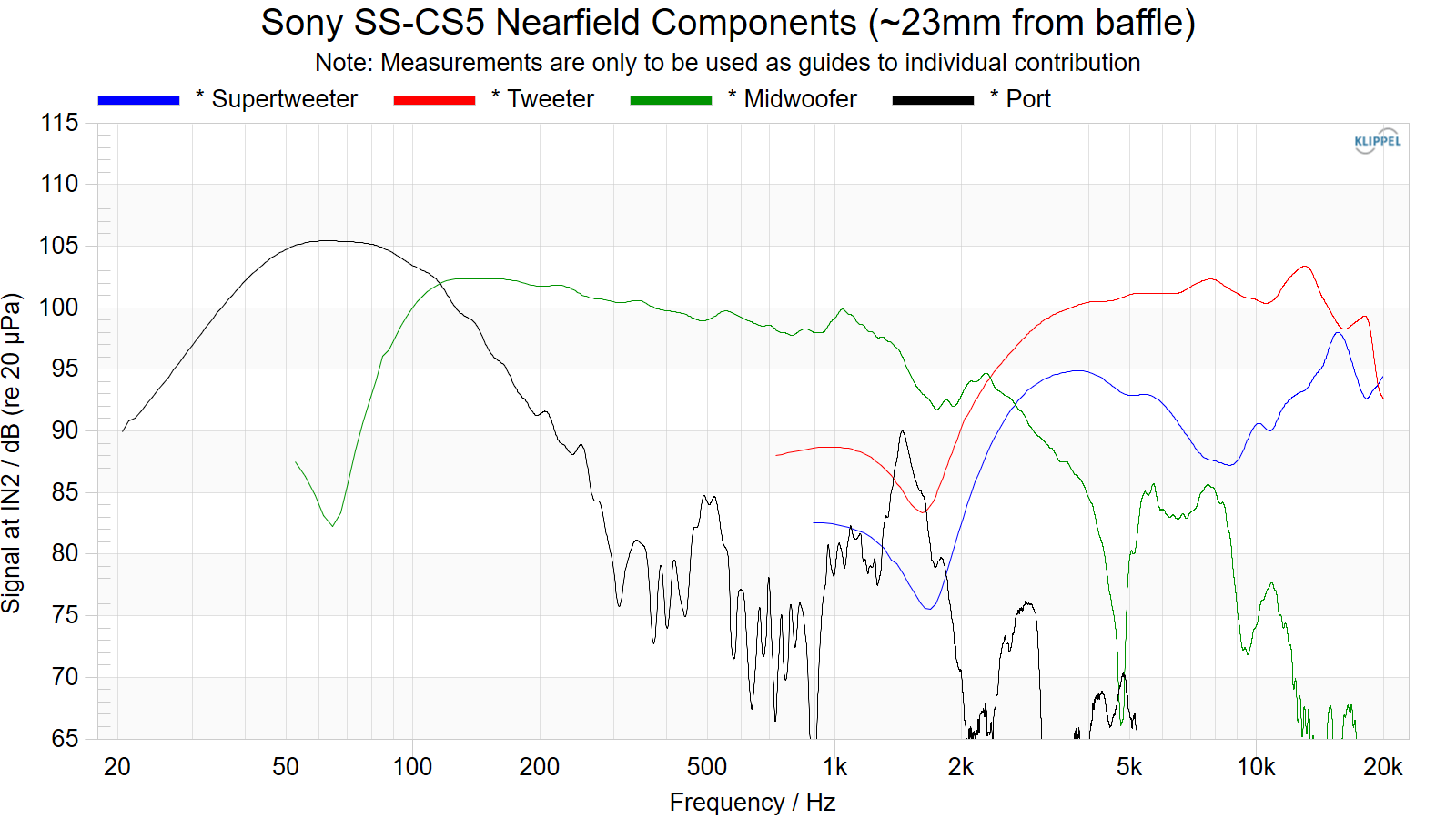
Harmonic Distortion
Harmonic Distortion at 86dB @ 1m:
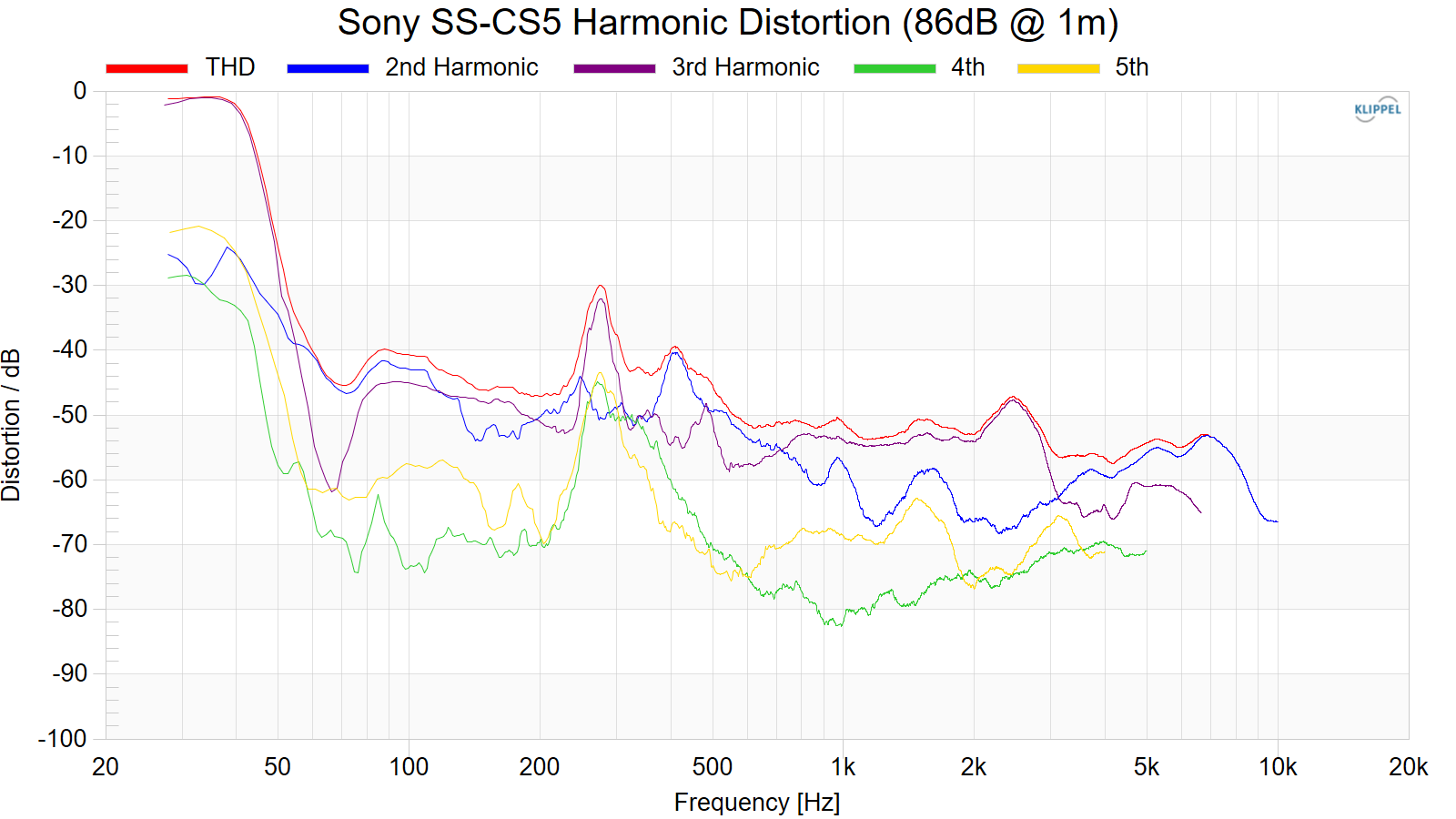
Harmonic Distortion at 96dB @ 1m:

Dynamic Range (Instantaneous Compression Test)
The below graphic indicates just how much SPL is lost (compression) or gained (enhancement; usually due to distortion) when the speaker is played at higher output volumes instantly via a 2.7 second logarithmic sine sweep referenced to 76dB at 1 meter. The signals are played consecutively without any additional stimulus applied. Then normalized against the 76dB result.
The tests are conducted in this fashion:
- 76dB at 1 meter (baseline; black)
- 86dB at 1 meter (red)
- 96dB at 1 meter (blue)
- 102dB at 1 meter (purple)
The purpose of this test is to illustrate how much (if at all) the output changes as a speaker’s components temperature increases (i.e., voice coils, crossover components) instantaneously.
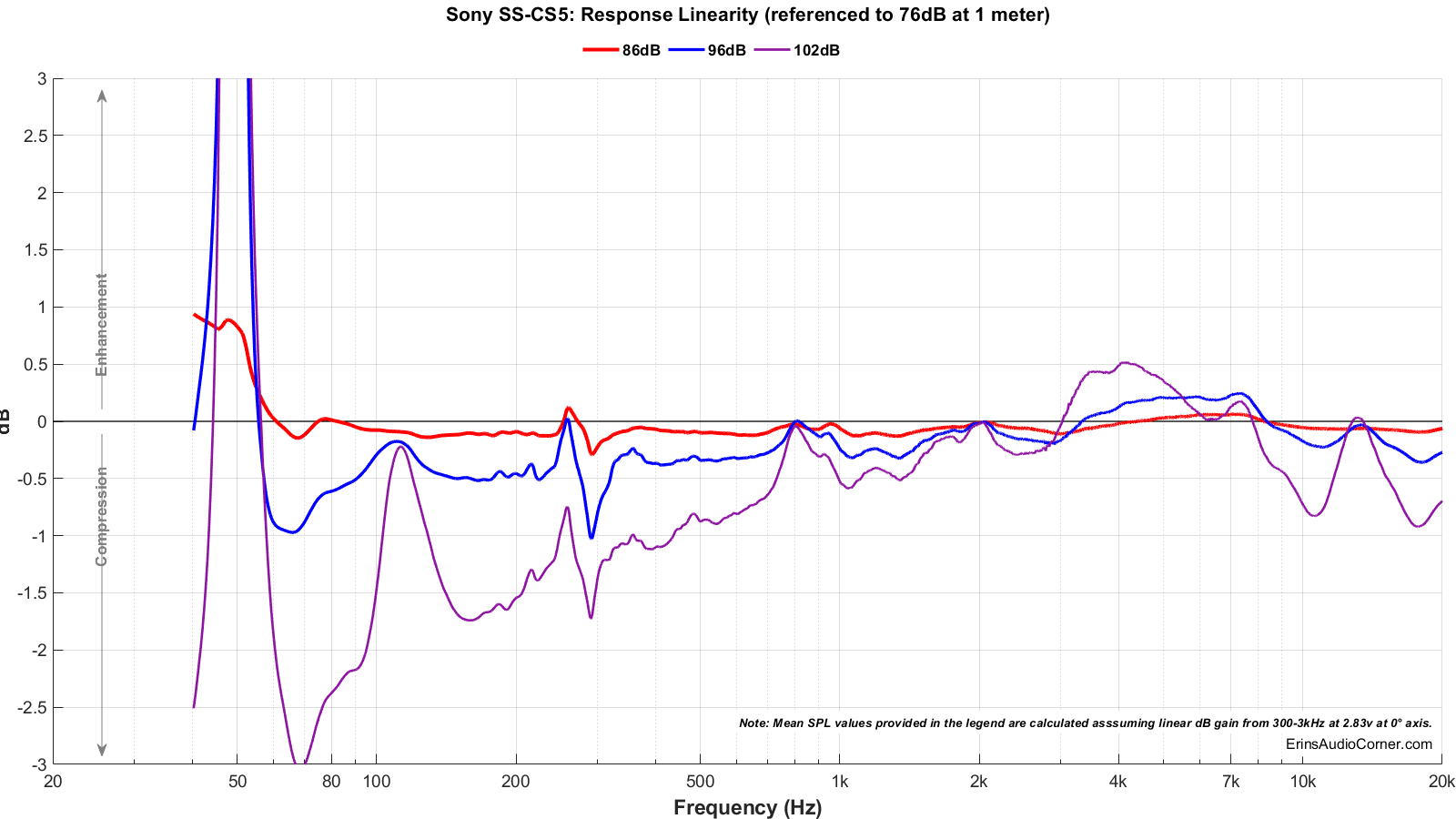
Long Term Compression Tests
The below graphics indicate how much SPL is lost or gained in the long-term as a speaker plays at the same output level for 2 minutes, in intervals. Each graphic represents a different SPL: 86dB and 96dB both at 1 meter.
The purpose of this test is to illustrate how much (if at all) the output changes as a speaker’s components temperature increases (i.e., voice coils, crossover components).
The tests are conducted in this fashion:
- “Cold” logarithmic sine sweep (no stimulus applied beforehand)
- Multitone stimulus played at desired SPL/distance for 2 minutes; intended to represent music signal
- Interim logarithmic sine sweep (no stimulus applied beforehand) (Red in graphic)
- Multitone stimulus played at desired SPL/distance for 2 minutes; intended to represent music signal
- Final logarithmic sine sweep (no stimulus applied beforehand) (Blue in graphic)
The red and blue lines represent changes in the output compared to the initial “cold” test.

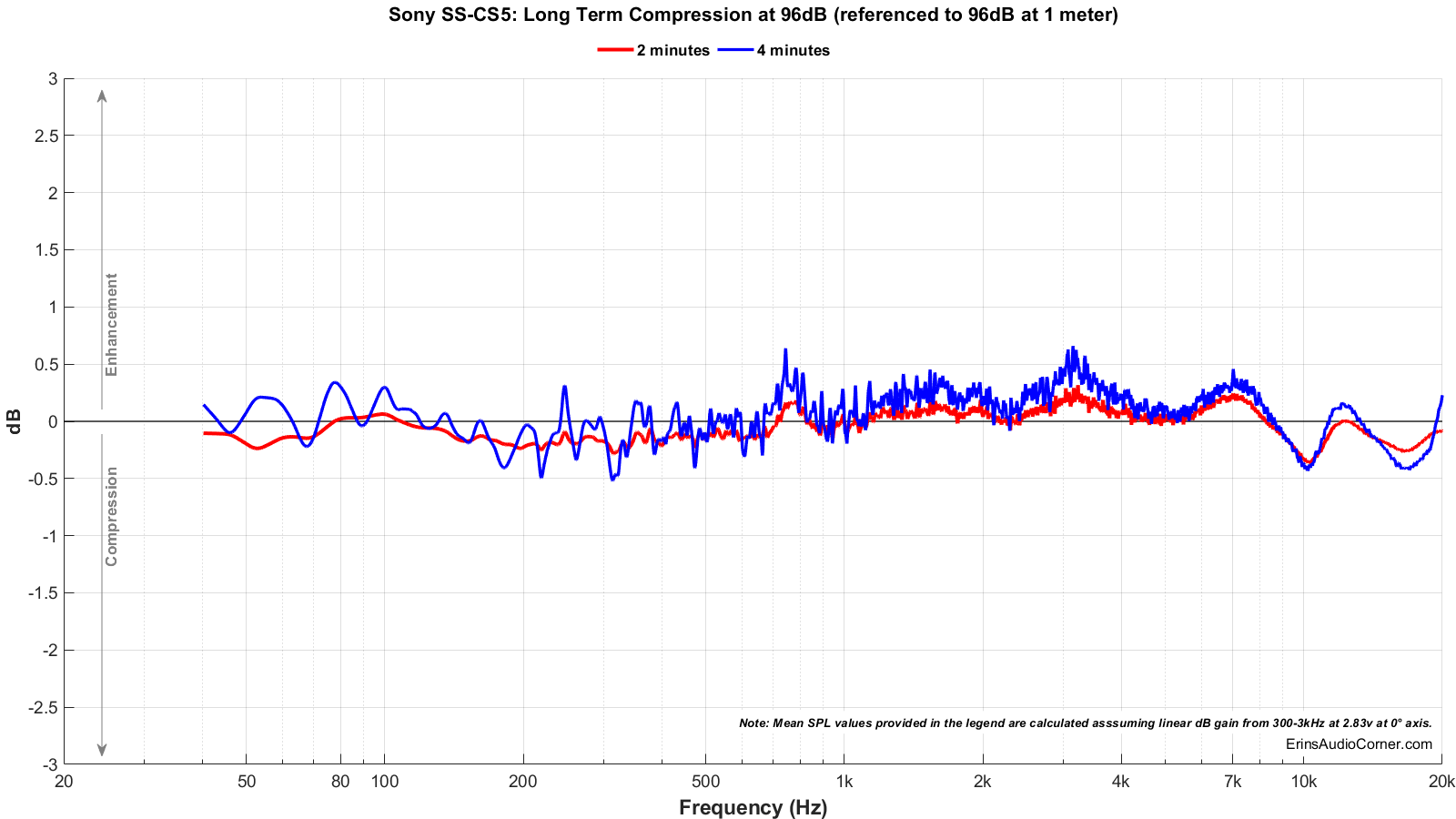
Without the Supertweeter
What happens if you disconnect the supertweeter?

Enclosure Resonance Insight
(Cabinet Vibration - Cumulative Spectral Decay (CSD))
Cabinet resonances are responsible for the non-linearity in the 1-2kHz region with the most notable being the contribution from the width dimension resulting in a long-standing wave at around 1kHz.
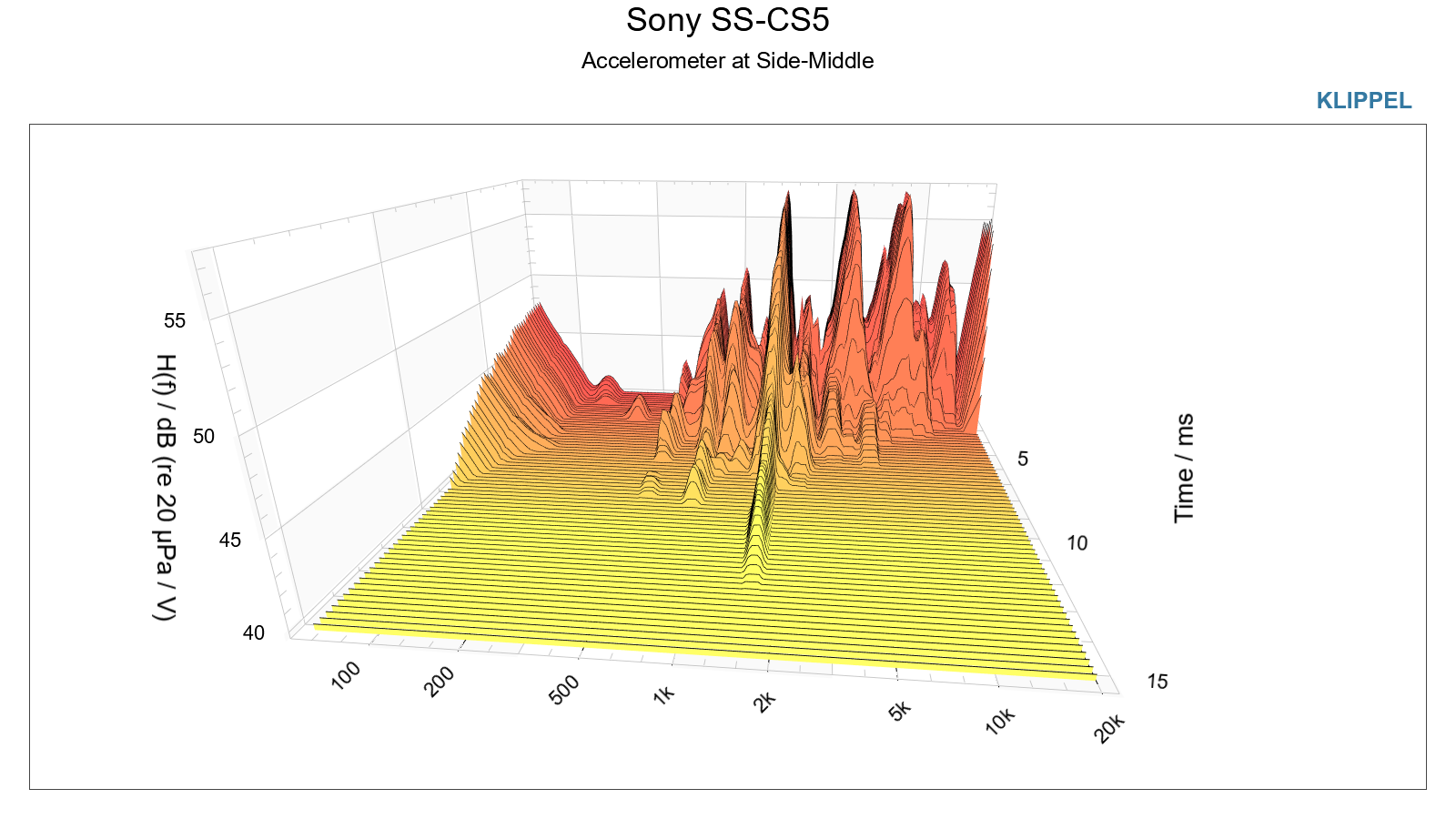

Parting / Random Thoughts
If you want to see the music I use for evaluating speakers subjectively, see my Spotify playlist.
I always listen to speakers before I measure them. This ensures I am not swayed by the measurements before I listen. Listening done on-axis but I also turned the speakers to face out into the room as well. I found on-axis to provide the best overall response. Listening volume between 80-95dB at 4m.
- A clear lack of bass. This is no surprise based on the data but is still rather disappointing the bass doesn’t extend at least a little bit further than the F3 of 83Hz and F10 of 60Hz. Meaning, when this speaker starts rolling off, it rolls off pretty quickly. It absolutely needs a subwoofer even for short distances/low output.
- Distortion accompanies the relatively high rolloff frequency below 100Hz.
- Sensitivity is a reasonable 86.2dB and the load is relatively benign meaning that a regular ol’ AVR should drive this speaker just fine.
- That little supertweeter is the key to labeling this speaker as “hi-res” capable, I’m sure. Funny enough, it does little-to-nothing to really help the response other than add a bit of treble at the 16kHz region. I disconnected it and did prefer the sound that way. But I suppose it can’t really hurt to leave it connected. The one bad thing about it, though, is vertical positioning is a pain. A few degrees up or down off the reference line (between the tweeter/supertweeter) can make or break the response >10kHz. So watch out for that.
- The compression is better than I expected. It’s not good. Just better than I expected it would be based on seeing the other data. Still, it can’t be pushed too loudly. Using a subwoofer with a crossover point of greater than 100Hz would really help this speaker out.
- The linearity is a bit all over the place in the upper-mid to high frequency range. You can’t fix the peak/dip combo around 2-3kHz but you can take care of the dip around 7kHz. Most AVRs with auto-EQ should be a big help. But, even turning the speaker to about 20° off-axis will smooth things out a good deal.
Let’s be real. This is a budget darling. I paid $88 for the pair. Most people are paying $130 or less. The performance is OK. It’s not going to knock your socks off with fidelity (nor bass) but it’s a good option for someone starting out.
As stated in the Foreword, this written review is purposely a cliff’s notes version. For more details about the performance (objectively and subjectively) please watch the YouTube video.
Support / Contribute
If you find this review helpful and want to help support the cause that would be AWESOME! There are a few ways you can do so below. Your support helps me pay for new items to test, hardware, miscellaneous items needed for testing, new speakers to review and costs of the site’s server space and bandwidth. Any help is very much appreciated.
Join my Patreon: Become a Patron!
Shopping
If you are shopping at any of the following stores then please consider using my generic affiliate links below to make the purchase through.
Purchases through these links can earn me a small commission - at no additional cost to you - and help me continue to provide the community with free content and reviews. Doesn’t matter if it’s a TV from Crutchfield, budget speakers from Audio Advice or a pair of socks from Amazon, just use the link above before you make your purchase. Thank you!